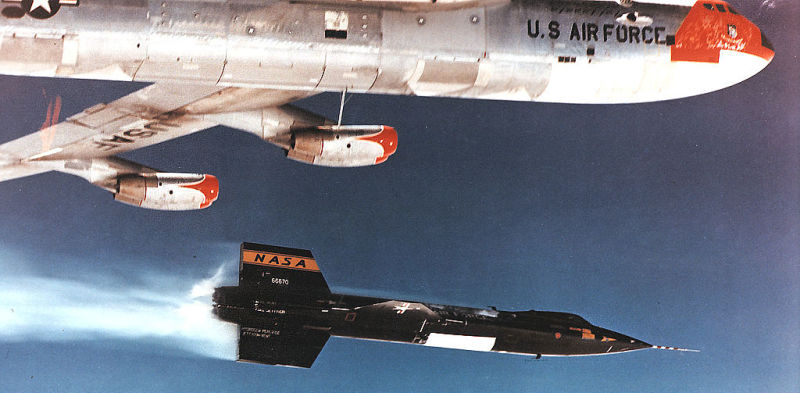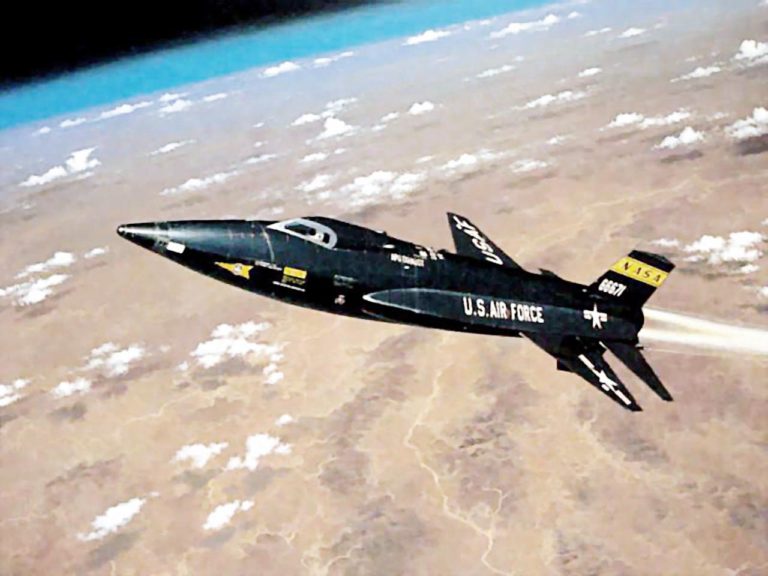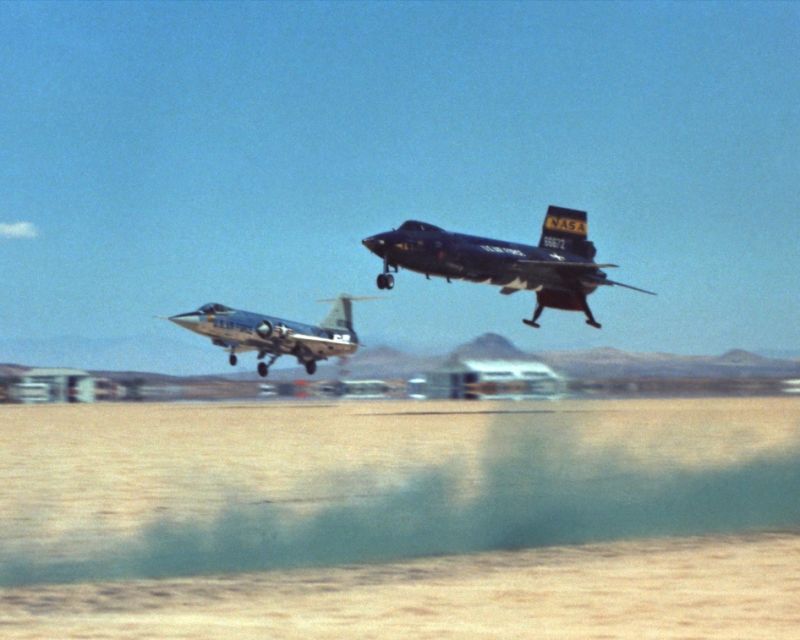Testimony of Pilot# 8
I thought the attractions of being an astronaut were actually, not so much the Moon, but flying in a completely new medium.
The pictures above do not represent the common perspective of Neil Armstrong the astronaut and first man to step on the moon. Rather using our characterization of harnessing the sky, they and this post provides a testimony of pilot – Korean War Navy fighter pilot and a NACA/NASA research pilot – related to exploring the hypersonic flight regime existing above Mach 5 and the study of the possibilities of flying a winged vehicle outside the sensible atmosphere – the region where aerodynamic control surfaces will function. TINS
Trouble At the Edge of Space
from
First Man –
The Life of Neil Armstrong
The Authorized Biography
by James R. Hansen
“. . . I always felt that ‘form follows function,’ that engineering would decide the best way to go. I thought the attractions of being an astronaut were actually, not so much the Moon, but flying in a completely new medium.” This is not to say that Armstrong did not continue to prefer a winged pathway into space, via trans-atmospheric vehicles like the X-15 and X-20 Dyna-Soar. Even after the first suborbital Mercury flights in 1961, Armstrong thought “we were far more involved in spaceflight research than the Mercury people. “I always felt that the risks we had in the space side of the program were probably less than we had back in flying at Edwards or the general flight-test community. The reason is that we were exploring the frontiers, we were out at the edges of the flight envelope all the time, testing limits. That isn’t to say that we didn’t expect risks in the space program. But we felt pretty comfortable because we had so much technical backup and we didn’t go nearly as close to the limits as much as we did back in the old flight-test days.”
A significantly higher rate of fatalities in the world of flight test supports Armstrong’s contention.
… the X-15 was constructed not just to explore the hypersonic flight regime existing above Mach 5 but also to study the possibilities of flying a winged vehicle outside the sensible atmosphere (the region where aerodynamic control surfaces will function). First flown in June 1959, the rocket-powered X-15 was a veritable “aerospace plane.” By the end of 1961, the year President Kennedy committed the nation to the Moon landing, the X-15 attained its primary design goals of flying to a speed in excess of Mach 6 (over 4,000 mph) and to an altitude of over 200,000 feet (or nearly thirty-eight miles high). In 1962, a year that saw the Mercury flights of astronauts Glenn, Carpenter, and Schirra, air force pilot Robert White, in a pressure suit similar to the Mercury space suit, flew the X-15 more than fifty miles high (264,000 feet), the altitude that technically qualified him as an “astronaut” according to a policy invented by the U.S. Air Force (and never endorsed by NASA). The total number of X-15 pilots who earned “astronaut wings” according to the air force definition was eight. That was one more than the original group of Mercury astronauts, only six of whom made it into space (and only four into orbit) as part of the Mercury program.
On April 5, Armstrong made X-15 flight 3-3-7. Accelerating to a top speed of Mach 4.12, Neil thundered up to 180,000 feet. It was the first time he had reached a high enough altitude to fully integrate the MH-96 reaction controls. The test flight spanned 181.7 miles in a little over eleven minutes before landing at Rogers Dry Lake.
The airplane still had not been flown to the point of testing the MH-96 system limit, or “g limiter,” in part designed by Armstrong, to prevent the pilot from exceeding 5 g’s, and he “felt the obligation to demonstrate every component and aspect of the MH-96.”
It was this commitment that led to Armstrong’s making what some came to feel was his biggest pilot error in the X-15 program.
Flight 3-4-8 occurred on Friday, April 20, 1962. Armstrong remembers, “It was the highest I’d ever gone”—to 207,500 feet, an altitude that remained his highest until Gemini VIII. “The views were spectacular. The system ran pretty well up there. The reaction control systems were operating satisfactorily ‘across the top.’ It kept a good attitude reference. Everything worked well. It was well outside the atmosphere so that we were flying completely on reaction controls. Aerodynamic controls were completely ineffective, like flying in a vacuum.”
Coming down from peak altitude, part of the flight plan was to check out the g limiter. Armstrong explains, “I thought I got the g’s high enough, but it was not kicking in. That was my job, to check out that system.”
Armstrong let the X-15 nose up just a little, causing it to balloon to a high enough altitude—roughly 140,000 feet—where “the airplane returned to the wings-level attitude with essentially no sideslip. At about fifteen or sixteen degrees angle of attack and four g, I elected to leave the angle of attack in that mode and I was hoping that I would see the g limiting in action. We had seen g limiting on the simulator operation at levels approximately four g to four and a half g and it wasn’t obvious that we were not having any g limiting, so I left it at this four-g level for quite a long time hoping that this g limiting might show up. It did not, and apparently this is where we got into the ballooning situation.”
Over the radio, “NASA 1” back at the main flight control center told Neil rather emphatically, “We show you ballooning, not turning. Hard left turn, Neil! Hard left turn!” “Of course I’m trying to turn,” Neil explains forty years after the flight, “but nothing’s happening. I’m just on a ballistic path and I get over on to a very steep bank angle trying to pull down into the atmosphere. But the aerodynamics are not doing anything. The plane’s going to go where it’s going to go. It’s on a ballistic path. They’re telling me on the ground to ‘Turn!’ but that’s not any help to me. They could see on the instruments that my servos are at full stabilizer turning position. I rolled over and tried to drop back into the atmosphere, but the aircraft wasn’t going down because there was no air to bite into.
“I had no reason to suspect that ballooning would cause any trouble, because I had fiddled around with this lots of times in the simulator and never, never had any kind of problem with bouncing out like that.”
Eventually the X-15 fell back down into the atmosphere where Armstrong was able to start making the turn. But by that time, Neil recalls, the airplane had gone “sailing merrily by the field”—at a speed of Mach 3! By the time he rolled into a bank, pulled up the angle of attack, and started to turn back in a northeasterly direction toward Edwards, Armstrong found himself approaching Pasadena. Neil was forty-five miles south of Edwards and still above 100,000 feet. (Subsequent Edwards lore suggesting that Neil flew the X-15 as far south as the Rose Bowl seems an exaggeration, since forty miles south of Edwards is substantially north of the Rose Bowl. Downward visibility was very limited for the X-15 pilot, so Neil did not know how far south he got.)
“It wasn’t clear at the time I made the turn whether I would be able to get back to Edwards. That wasn’t a great concern to me because there were other dry lakes available. I did not want to go into another one, but I certainly would if I had needed to. My easiest choice was to land at a lake called El Mirage, and I could easily get there. The only other alternative at that point would have been Palmdale municipal airport, and I didn’t want to get into their traffic pattern.” So Armstrong committed himself to trying for Edwards: “After I got on the track—the northbound track for Edwards—it was clear that I was going to be able to try to go in. I’d have to make a ‘straight in.’ ”
… Armstrong’s X-15 flight of April 20, 1962, established X-15 program records for the longest endurance (12:28:07) and for longest distance (350 miles, ground track).
Local Edwards lore still relates that Armstrong was trekking right down amid the Joshua trees as he made his landing on the southern tip of Rogers Dry Lake; in fact, the jest was that the Joshua trees were passing by above Neil. But that was a gross exaggeration devised by the boys in the chase planes, the only ones close enough to Neil’s set-down point to know exactly where it occurred.
Fellow NASA test pilot Bruce Peterson was situated on the north lake bed waiting to send up locator flares. “Neil was supposed to land on runway 18 [“18” was short for 180-degrees heading] on the north lake bed,” Peterson relates. “Then I heard on the radio that he was going to go to the south lake, so I got in my vehicle and I must have been doing a hundred miles per hour, racing down that lake bed to see if I could get to the south lake bed and throw some flares. I watched him come in and looking across the lake, you can’t see relative distances. But I knew he was close to the edge of the lake.”
One of the engineers who monitored the flight, John McTigue, remembers “later kicking myself in the backside because I didn’t tell Neil to get rid of the lower ventral, because that would have reduced the drag some. But it was the only airplane that the little old lady in Pasadena had ever seen come roaring above her, the X-15!” Though he did not see Neil’s landing, McTigue heard that Armstrong barely made it back to South Base. Gathering for the postflight debriefing, McTigue heard Joe Vensel, the head of FRC flight operations, ask pilot Forrest Petersen, “How far was Neil from the Joshua trees?” Petersen thought for a moment and said, “Oh, probably a 150 feet or so.” A wry smile coming to his face, Vensel asked, “Were the trees to his right or left?!”
… Whether Armstrong could have pulled the necessary g’s to get the g limiter to kick in without getting off his flight profile, no one can be sure. “There were ways to do the test he did without going to Pasadena,” suggests NASA test pilot Bill Dana. “But that’s kind of second-guessing. He just didn’t realize how far up the nose had gone.
” Typically, Armstrong regards his infamous “overshoot to Pasadena” as “a learning thing.” Bill Dana concurs: “Neil was doing what he thought was the right thing. And if it won him a trip to Pasadena, why, he would not be doing that again! Probably nobody ever zoomed out of the atmosphere again on the X-15, because the pilots were all trained on the danger of that action based on what happened to Neil.”
“He wasn’t a screwup and he wasn’t accident prone,” declares Roger Barnicki, a technician in the Flight Research Center’s Research Pilots Branch who was responsible for Armstrong’s and other test pilots’ personal flight equipment. “This guy was by the numbers, not fanatical, but by the numbers.” (pp.178-184)
… Between the time of Neil’s first X-15 flight in November 1960 and his last in July 1962, the X-15 made thirty-five test flights; Neil flew seven, or one-fifth, of them. It has always been Neil’s understanding that, if he had stayed on at Edwards, he would likely have become the X-15 program’s chief test pilot. In that capacity, he would have flown the X-15 even more frequently, likely at a rate of one every four flights. “I liked the people I worked with at Edwards,” Armstrong recollects. “There was no reason to try to change things to get into a new field. Staying with the X-15, that was very attractive. It was a real project. It was good. I enjoyed it.” In the end, he just did not decide to do it.
Research Center colleague Milt Thompson has written that Neil was “the most technically capable of the early X-15 pilots” and “the most intelligent of all the X-15 pilots, in a technical sense.” Bruce A. Peterson, the NASA test pilot whose spectacular (and, amazingly, nonfatal) accident in the M2-F2 lifting body at Edwards in 1967 served as the opening footage for the popular ’70s television show The Six Million Dollar Man, says that Neil “made a point of wanting to understand everything.” William H. Dana, who as a NASA research pilot flew in some of the most significant aeronautical programs ever carried out at what became NASA Dryden Flight Research Center, emphasizes how “bright” Armstrong was about the aircraft he flew: “He understood what contributed to a flight condition.
********************************
Armstrong came to NACA as a civilian test pilot by way of Purdue University and as a combat experienced naval aviator. He flew a total of 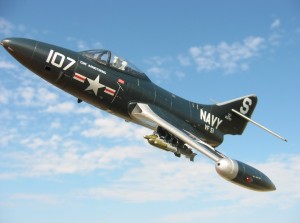 seventy-eight missions in the Korean War in VF-51 flying the F-9F-2 Panther off of the carrier Essex. Thirty of them were Combat Air Patrols, fifteen were photo escort, and one was for gunnery training. In the other thirty-two, he flew recce, fighter sweeps, rail cuts, and flak suppression. In all, Neil was in the air for over 121 hours.
seventy-eight missions in the Korean War in VF-51 flying the F-9F-2 Panther off of the carrier Essex. Thirty of them were Combat Air Patrols, fifteen were photo escort, and one was for gunnery training. In the other thirty-two, he flew recce, fighter sweeps, rail cuts, and flak suppression. In all, Neil was in the air for over 121 hours.
Over the years, a number of people have compared James Michener’s 1953 novel The Bridges at Toko-Ri to the historical record. What most have found are recognizable elements of at least four actual missions in the Toko-Ri story. Armstrong does not speculate on whether he flew on any of the four. All he has ever said is that “I flew into equally difficult places.”
Whether Neil flew as part of the attack cannot truly be answered, because the events depicted in the novel (made into a Hollywood movie starring William Holden, Mickey Rooney, and Grace Kelly) were highly fictionalized. Armstrong recalls that Michener, just off a Pulitzer Prize for his first book, Tales of the South Pacific, was a guest on the Essex during the last months of 1951. “So most of the things that happened in the book . . . were actual events,” Armstrong recounts. “I thought The Bridges at Toko-Ri was an excellent representation of the kinds of flying that we were doing there. It was identical, same kind of aircraft and the same class carrier.” Michener dedicated his book, to the Commander of Airwing Five (CAG) which included Armstrong’s VF-51 Marshall Beebe.
******************
From the time he came to Edwards in July 1955 to the time he left to join the astronaut corps at the end of September 1962, Armstrong made well over nine hundred total flights, an average of over ten flights per month.
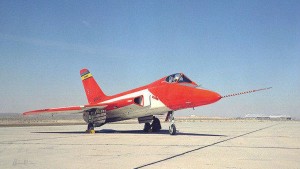 Most of his flights came in jets. More than 350 of his flights took place in one of the famous “Century” series fighters: the North American F-100 Super Sabre, the world’s first fighter capable of sustained supersonic speeds in level flight; McDonnell F-101 Voodoo; Convair F-102 Delta Dagger; Lockheed F-104 Starfighter; Republic F-105 Thunderchief; and Convair F-106 Delta Dart. The first time Armstrong broke the sound barrier came in October 1955, an F-100A flight investigation of longitudinal stability and control characteristics involving various wing slots and slats in different leading-edge configurations. In the picture above in June 1962, Armstrong prepares to fly a Douglas F5D-1 Skylancer to simulate aspects of a proposed space plane called the Dyna-Soar.
Most of his flights came in jets. More than 350 of his flights took place in one of the famous “Century” series fighters: the North American F-100 Super Sabre, the world’s first fighter capable of sustained supersonic speeds in level flight; McDonnell F-101 Voodoo; Convair F-102 Delta Dagger; Lockheed F-104 Starfighter; Republic F-105 Thunderchief; and Convair F-106 Delta Dart. The first time Armstrong broke the sound barrier came in October 1955, an F-100A flight investigation of longitudinal stability and control characteristics involving various wing slots and slats in different leading-edge configurations. In the picture above in June 1962, Armstrong prepares to fly a Douglas F5D-1 Skylancer to simulate aspects of a proposed space plane called the Dyna-Soar.
James R. Hansen, professor emeritus of history at Auburn University, is the author of the only official biography of Neil Armstrong, the first man on the moon, and a co-producer and co-director for the film adaption of the book, both titled, “First Man.”


